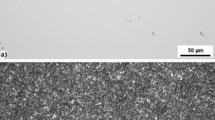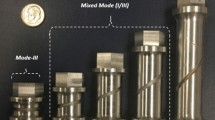Abstract
An analytical calibration of the Stable Poisson Loaded (SPL) specimen is presented. The specimen configuration is similar to the ASTM E-561 compact-tension specimen with displacement controlled wedge loading used for R-curve determination. The crack mouth opening displacements (CMOD's) are produced by the diametral expansion of an axially compressed cylindrical pin located in the wake of a machined notch. Due to the unusual loading configuration, a three-dimensional finite element analysis was performed with gap elements simulating the contact between the pin and specimen. In this report, stress intensity factors, CMOD's, and crack displacement profiles, are reported for different crack lengths and different contacting conditions. It was concluded that the computed stress intensity factor decreases sharply with increasing crack length thus making the SPL specimen configuration attractive for fracture testing of brittle, high modulus materials.
Similar content being viewed by others
References
J.C. NewmanJr., in Chevron-Notched Specimens Testing and Stress Analysis, ASTM STP 855, J.H. Underwood, S.W. Freiman and F.I. Baratta (eds.), ASTM, Philadelphia, PA (1984) 5–31.
G.T. Hahn, R.G. Hoagland, M.F. Kanninen and A.R. Rosenfield, in Dynamic Crack Propagation, G.S. Sih (ed.), Noordhoff, Leyden (1973) 649–662.
P.B. Crosley and E.J. Ripling in Crack Arrest Methodology and Applications, ASTM STP 711, G.T. Hahn and M.F. Kanninen (eds.), ASTM, Philadelphia, PA (1980) 321–337.
C.G. Annis and J.S. Cargill, in Fracture Mechanics of Ceramics, vol. 4, R.C. Bradt, D.P.H. Hasselman and F.F. Lange (eds.), Plenum Press, New York (1974) 737–744.
A.M. Calomino and D.N. Brewer, Journal of the American Ceramic Society 75, no. 1 (1992) 206–208.
A.M. Calomino, D.N. Brewer and L.G. Ghosn, ‘Fracture Behavior of Ceramics Under Displacement Controlled Loading’, NASA TM. 105565 (1992).
ASTM E 561–86, 1990 Annual Book of ASTM Standards, Metals Test Methods and Analytical Procedures, vol. 03.01, ASTM, Philadelphia, PA (1990) 571–582.
MARC General Purpose Finite Element Program, Version K.4, MARC Analysis Research Corporation, Palo Alto, CA, Jan. 1990.
R.S. Barsoum, International Journal of Numerical Methods in Engineering 10 (1976) 25–38.
D.M. Parks, International Journal of Fracture 10, no. 4 (1974) 487–502.
S.D. Conte and C. De-Boor, Elementary Numerical Analysis, (An Algorithmic Approach), Third ed., McGraw-Hill Book Co., New York (1980).
J.E. Srawley, International Journal of Fracture Mechanics 12 (1976) R475-R476.
Author information
Authors and Affiliations
Rights and permissions
About this article
Cite this article
Ghosn, L.J., Calomino, A.M. & Brewer, D.N. Analytical stress intensity solution for the stable Poisson loaded specimen. Int J Fract 60, 209–220 (1993). https://doi.org/10.1007/BF00012509
Received:
Accepted:
Issue Date:
DOI: https://doi.org/10.1007/BF00012509




